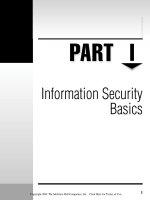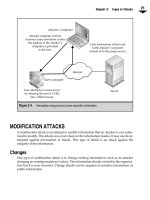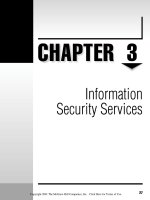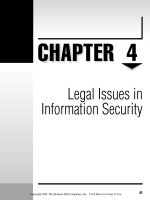Bảo mật hệ thống mạng part 25 pdf
Bạn đang xem bản rút gọn của tài liệu. Xem và tải ngay bản đầy đủ của tài liệu tại đây (276.12 KB, 8 trang )
Dual firewalls do increase the cost of the architecture and require additional manage
-
ment and configuration.
FIREWALLS
Firewalls have been mentioned a fair amount in the proceeding sections of this chapter
(and have been mentioned in various other chapters as well). A firewall is a network ac
-
cess control device that is designed to deny all traffic except that which is explicitly al
-
lowed. This definition contrasts with a router, which is a network device that is intended
to route traffic as fast as possible.
Some will argue that a router can be a firewall. I will agree that a router can perform
some of the functions of a firewall but one key difference remains: A router is intended
to route all traffic as fast as possible, not to deny traffic. Perhaps a better way to differen
-
tiate a router and a firewall is to say that a firewall is a security device that can allow ap
-
propriate traffic to flow while a router is a network device that can be configured to
deny certain traffic.
In addition to this, firewalls generally provide a more granular level of configuration.
Firewalls can be configured to allow traffic based on the service, the IP address of the
source or destination, or the ID of the user requesting service. Firewalls can also be con-
figured to log all traffic. Firewalls can perform a centralized security management func-
tion. In one configuration, the security administrator can define allowed traffic to all
systems within an organization from the outside. While this does not alleviate the need to
properly patch and configure systems, it does remove some of the risk that one or more
systems may be misconfigured and thus open to attack on an inappropriate service.
152
Network Security: A Beginner’s Guide
Sensitive Internal Networks
Firewalls should not be limited to use only on Internet connections. A firewall is a
network access control device that can be used anywhere that access must be con
-
trolled. This includes internal networks that should be protected from other internal
systems. Sensitive internal networks may include systems with extremely impor
-
tant information or functions or networks that conduct experiments on network
equipment.
A good example of a sensitive network can be found in banks. Every evening
banks communicate with the Federal Reserve System to transfer funds. A failure
here can cost the bank large sums of money. The systems that control this communi
-
cation are very sensitive and important to the bank. A firewall could be installed to
restrict access to these systems from other parts of the bank.
Types of Firewalls
There are two general types of firewalls: application layer firewalls and packet filtering
firewalls. The two types start with differing philosophies but with proper configuration
both types can perform the required security functions of blocking inappropriate traffic.
As we will see in the following sections, the way the two types are implemented does im
-
pact how the security policy is enforced.
Application Layer Firewalls
Application layer firewalls (also called proxy firewalls) are software packages that sit on top
of general-purpose operating systems (such as Windows NT or Unix) or on firewall ap
-
pliances. The firewall will have multiple interfaces, one for each network to which it is
connected. A set of policy rules defines how traffic from one network is transported to
any other. If a rule does not specifically allow the traffic to flow, the firewall will deny or
drop the packets.
Policy rules are enforced through the use of proxies. On an application layer firewall,
each protocol to be allowed must have its own proxy. The best proxies are those that are
built specifically for the protocol to be allowed. For instance, an FTP proxy understands
the FTP protocol and can determine if the traffic that is flowing is following the protocol
and is allowed by the policy rules.
With an application layer firewall, all connections terminate on the firewall (see Fig-
ure 9-12). As you can see from the figure, a connection starts on the client system and goes
to the internal interface of the firewall. The firewall accepts the connection, analyzes the
contents of the packet and the protocol to be used, and determines if the policy rules al-
low the traffic. If so, the firewall initiates a new connection from its external interface to
the server system.
Chapter 9: Internet Architecture
153
Figure 9-12.
Application layer firewall proxy connections
Application layer firewalls also use proxies for inbound connections. The proxy on
the firewall will receive the inbound connection and process the commands before the
traffic is sent to the destination system. In this way, the firewall can protect systems from
some application layer attacks.
NOTE:
This assumes that the proxy on the firewall is itself not vulnerable to the attack. If the proxy on
the firewall is not well written, this may not be the case.
Application layer firewalls will have proxies for the most commonly used protocols
such as HTTP, SMTP, FTP, and telnet. Other proxies may not be available. If a proxy is not
available, the protocol cannot be used across the firewall.
The firewall also hides the addresses of systems behind the application layer firewall.
Since all connections originate and terminate on the firewall’s interfaces, internal systems
are not directly visible to the outside and thus the internal addressing scheme can be hidden.
Packet Filtering Firewalls
Packet filtering firewalls may also be software packages that sit on top of general-
purpose operating systems (such as Windows NT or Unix) or on firewall appliances.
The firewall will have multiple interfaces, one for each network to which it is connected.
And also like the application layer firewall, a set of policy rules define how traffic from
one network is transported to any other. If a rule does not specifically allow the traffic to
flow, the firewall will deny or drop the packets.
Policy rules are enforced through the use of packet inspection filters. The filters exam-
ine the packets and determine whether the traffic is allowed based on the policy rules and
the state of the protocol. If the protocol is running over TCP, state determination is rela-
tively easy as TCP itself maintains state.
If the protocol is running over UDP, the packet filtering firewall cannot use the inher
-
ent state of the protocol but must track the state of the UDP traffic. Normally, the firewall
will see an outbound UDP packet and expect an inbound packet from the destination ad
-
dress and port of the original packet within a certain time frame. If the packet arrives
within the time frame, the packet is accepted. If not, the firewall determines that the UDP
traffic is not a response to a request and drops it.
With a packet filtering firewall, connections do not terminate on the firewall (see Fig
-
ure 9-13) but instead travel directly to the destination system. As the packets arrive at the
firewall, the firewall will determine if the packet and connection state are allowed by the
policy rules. If so, the packet is sent on its way. If not, the packet is denied or dropped.
Packet filtering firewalls do not rely on proxies for each protocol and thus can be used
with any protocol that runs over IP. As a general rule, they are also capable of handling a
greater amount of traffic as they do not have the overhead of extra connection setups and
the processing that goes with the proxy software.
154
Network Security: A Beginner’s Guide
NOTE:
I said “as a general rule” in the last paragraph. Different firewall vendors will compare the per-
formance of their firewalls in different ways. Historically, packet filtering firewalls have been able to pro-
cess a greater amount of traffic than the application layer firewalls on the same type of platform. This
comparison may vary depending on the type of traffic and the number of connections during the test.
Strict packet filtering firewalls do not use proxies and thus traffic from a client is sent
directly to the server. If an attack is launched against the server on an open service that is
allowed by the firewall policy rules, the firewall will not interfere with the attack. Packet
filtering firewalls may also allow the internal addressing scheme to be seen from the out
-
side. Internal addresses do not need to be hidden since the connections do not terminate
on the firewall.
Hybrids
As with many things, firewalls evolved over time. Manufacturers of application layer
firewalls realized that they needed some way of handling protocols for which specific
proxies did not exist. Thus was born the generic services proxy (GSP). The GSP was cre
-
ated to allow application layer proxies to handle other protocols needed by security and
network administrators. In reality, what the GSP did was to create a way for application
layer firewalls to act like packet filtering firewalls.
The manufacturers of packet filtering firewalls also added some proxies to their prod
-
ucts to allow for greater security for some well-known protocols. Many packet filtering
firewalls now come with an SMTP proxy, for example.
Chapter 9: Internet Architecture
155
Figure 9-13.
Traffic through a packet filtering firewall
156
Network Security: A Beginner’s Guide
While both types of firewalls still have the basic functionality of the original design
(and thus most of the basic weaknesses as well), we now have many hybrid firewalls on
the market. It is almost impossible to find a pure application layer or pure packet filtering
firewall. This is not a bad turn of events as it allows security administrators to tailor the
solution to their particular circumstances.
Firewall Configurations
Now let’s take a look back at the DMZ architectures that we have covered earlier in the
chapter and see how a firewall would be configured specifically for those situations. For
this exercise, we will assume that the following systems exist in the DMZ:
▼
Web server offering service on port 80 only.
▲
Mail server offering service on port 25 only. This system accepts all inbound
mail and sends all outbound mail. The internal mail server contacts this system
periodically to get inbound mail and send outbound mail.
There is an internal DNS system that must query Internet systems to resolve names to
addresses but the organization does not host its own primary external DNS.
The Internet policy for the organization allows internal users to use the following
services:
▼ HTTP
■ HTTPS
■ FTP
■ Telnet
▲
SSH
Based on this policy, we can construct policy rules for each of the DMZ architectures.
Router and Firewall
The router and firewall architecture was shown earlier in Figure 9-9. Table 9-1 provides
the rules for the firewall.
Filtering can be placed on the router to only allow HTTP from the outside to the Web
server and SMTP from the outside to the mail server.
Single Firewall
The single-firewall architecture was shown earlier in Figure 9-10. Table 9-2 provides the
rules for the firewall.
As you can see from Table 9-2, the rules are very similar to those for the router and
firewall architecture. The firewall adds rules that were handled by the router in the previous
Chapter 9: Internet Architecture
157
ous architecture. You can also see that there is no explicit rule that allows the internal mail
server to connect to the mail server in the DMZ. This is because of rule #2, which allows
any system (internal or external) to connect to that system.
Dual Firewalls
The dual-firewall architecture was shown earlier in Figure 9-11. Table 9-3 provides the
rules for firewall #1.
Rule
Number Source IP Destination IP Service Action
1 Internal mail server Mail server SMTP Accept
2 Internal network Any HTTP, HTTPS, FTP,
Telnet, SSH
Accept
3 Internal DNS Any DNS Accept
4 Any Any Any Drop
Table 9-1.
Firewall Rules for the Router and Firewall Architecture
Rule
Number Source IP Destination IP Service Action
1 Any Web server HTTP Accept
2 Any Mail server SMTP Accept
3 Mail server Any SMTP Accept
4 Internal network Any HTTP, HTTPS,
FTP, Telnet, SSH
Accept
5 Internal DNS Any DNS Accept
6 Any Any Any Drop
Table 9-2.
Firewall Rules for the Single-Firewall Architecture
As you can see from Table 9-3, the rules are the same as those of the firewall in the
single-firewall architecture. However, there is a second firewall. The rules for firewall
#2 can be found in Table 9-4.
NOTE:
These examples are very simple but they serve to get the point across as to how the firewalls
work to only allow appropriate access.
158
Network Security: A Beginner’s Guide
Rule
Number Source IP Destination IP Service Action
1 Any Web server HTTP Accept
2 Any Mail server SMTP Accept
3 Mail server Any SMTP Accept
4 Internal
network
Any HTTP, HTTPS, FTP,
Telnet, SSH
Accept
5 Internal DNS Any DNS Accept
6 Any Any Any Drop
Table 9-3.
Firewall Rules for Firewall #1 in the Dual-Firewall Architecture
Rule
Number Source IP Destination IP Service Action
1 Internal mail
server
Mail server SMTP Accept
2 Internal network Any HTTP, HTTPS, FTP,
Telnet, SSH
Accept
3 Internal DNS Any DNS Accept
4 Any Any Any Drop
Table 9-4.
Firewall Rules for Firewall #2 in the Dual-Firewall Architecture
Chapter 9: Internet Architecture
159
Firewall Rule Set Design
Good rule set design can be as important to a firewall as good hardware. Most firewalls
work on “first match” when deciding whether to accept or reject a packet. When design
-
ing a rule set, the “first match” algorithm dictates that the most specific rules be placed at
the top of the rule set and the least specific or most general rules be placed at the bottom.
This placement guarantees that more general rules do not mask the more specific rules.
NOTE:
Some firewalls provide a rule set processor that examines the rule set for rules that are
masked by other rules. The processor then flags this condition for the firewall administrator before in
-
stalling the rules on the firewall.
While this is a good general guideline, it does not address the performance issue of
the firewall. The more rules that must be examined for each packet, the more processing
must be done by the firewall. Good rule set design must take this into account to make the
firewall more efficient.
To do this, look at the expected traffic load of the firewall and rank the traffic types in
order. Generally, HTTP traffic will be the largest. To make the firewall more efficient,
place the rules pertaining to HTTP at the top of the rule set. In most cases, this means that
the rule allowing internal systems to use HTTP to any system on the Internet and the rule
allowing external users to access the organization’s Web site should be very near the top
of the rule set. The only rules that should be above them will be specific deny rules per-
taining to HTTP.
NETWORK ADDRESS TRANSLATION
At first glance, IP addressing does not seem like a topic for a security book. The address
-
ing of systems is clearly a network administration issue, of course. Well, not quite. Any
organization that plans to install a firewall will have to deal with addressing issues. In
fact, addressing that is not well thought out and configured properly can cause many
headaches. At the root of the problem is the shortage of IP address space. The familiar
32-bit addresses in the dot notation (xxx.yyy.zzz.aaa) are simply being used up. Because
of this, ISPs are reluctant to give out large blocks of addresses to their customers. Most
ISPs will provide blocks of 16 or 32 addresses (which actually become 14 or 30 addresses
when the broadcast addresses are taken into account). Thirty addresses are not enough
for a small organization, never mind a medium or large organization. Most organizations
have more than 30 systems. So what do you do? The solution is called network address
translation (NAT).









